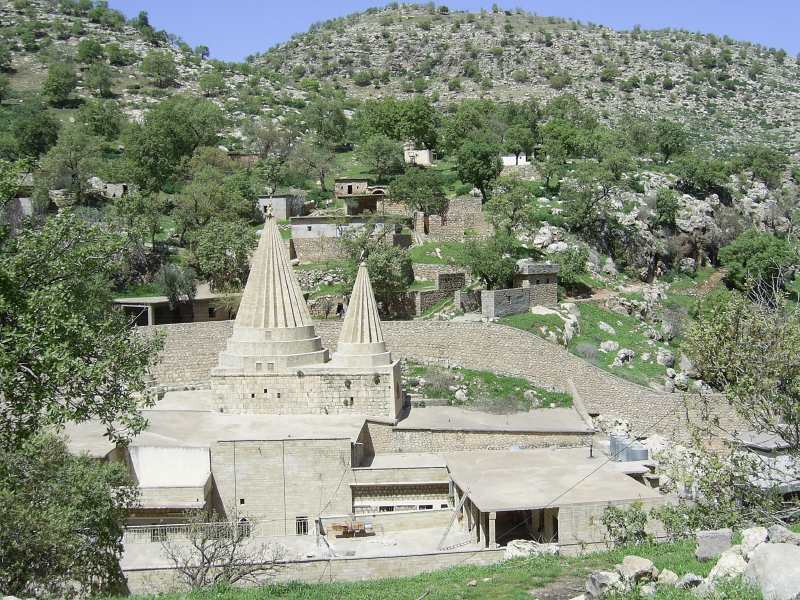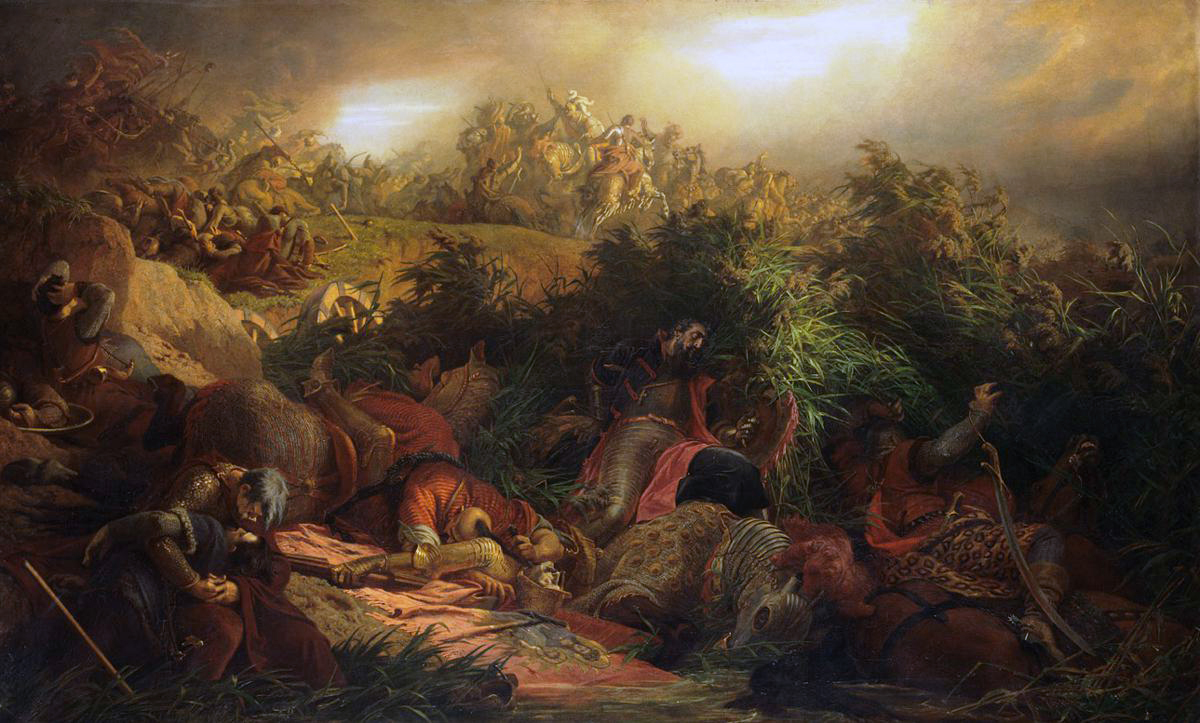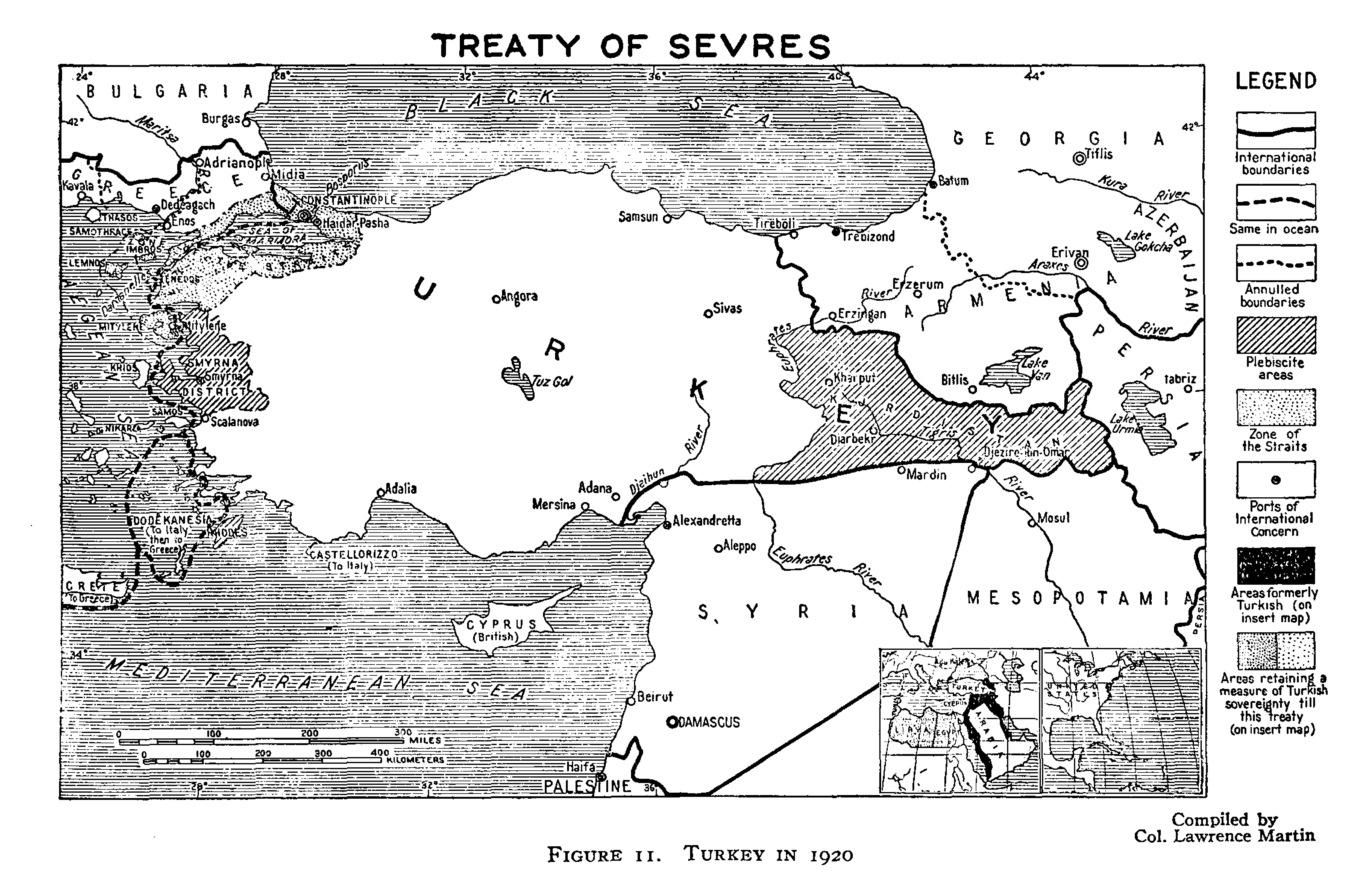|
Shaykhan Principality
The Daseni Principality (, ), also known as the Shaykhan (or Sheikhan) Principality as its administration was centered in the Ain Sifni, Sheikhan region (which included the primary Yezidi holy site of Lalish), was a semi-autonomous Yezidi Kurdish emirate. Established by the Daseni tribe around 906 AD following a rebellion against Hamdanid authority, it existed until 1832 when it was militarily conquered by the Soran Emirate under Muhammad Kor of Rawanduz, a campaign that culminated in widespread massacres and the execution of the last Daseni ruler, Ali Beg. Territory The core territory of the Daseni Principality encompassed the northern and eastern foothills surrounding Mosul, along with key centers such as Ain Sifni, Sheikhan (its main base), the holy site of Lalish, Duhok, Dohuk-e Dasinya (meaning "Dohuk of the Daseni/Yazidis"), Khabat District, Kalak-e Dasinya ("Kalak of the Daseni/Yazidis")'','' Simele, Simel'','' and the Sinjar region''.'' For a period in the 16th century, b ... [...More Info...] [...Related Items...] OR: [Wikipedia] [Google] [Baidu] |
Ain Sifni
Ain Sifni (, , ) also known as Shekhan (), is a town and subdistrict in Nineveh Governorate, Iraq. It is located in the Shekhan District in the Nineveh Plains. Ain Sifni is largely populated by Yazidis, most of whom speak Kurmanji Kurdish. In the town, there is a Chaldean Catholic church of Mar Yousif, and a church of Mar Gewargis of the Ancient Church of the East. There are also seven Yazidi religious monuments, including mausoleums of Sheikh ‘Alî Chamse and Sheikh Hantuch, and shrines of Sheikh Adi, Nishingaha Peroz, and Sheikh Mushelleh. Etymology The Kurdish name of the town is derived from the plural form of "sheikh" ("holy man" in Kurdish), and thus translates to " he land of theholy men". According to Yazidi tradition, Shekhan means "two sheikhs" and referred to the first time that Abdulqadir Gilani, founder of Qadiriyya, and Adi ibn Musafir, founder of Adawiyya, had met, which was on the site of what later became Shekhan. The Arabic name, Ain Sifni, is interpr ... [...More Info...] [...Related Items...] OR: [Wikipedia] [Google] [Baidu] |
Adi Ibn Musafir
Adi ibn Musafir (, ; born 1072–1078, died 1162) was a Sunni Muslim sheikh who founded the Adawiyya order. He is also considered a Yazidi saint. The Yazidis consider him as an avatar of Tawûsî Melek, which means "Peacock Angel". His tomb at Lalish, Iraq is a focal point of Yazidi pilgrimage. He was an Arab from the Umayyad dynasty. He had distant Kurdish heritage as a direct descendant of Marwan II, who was born to a Kurdish mother. Biography Sheikh Adi was born in the 1070s in the village of Bait Far, near Baalbek, in the Beqaa Valley of present-day Lebanon. He hailed from the Umayyad lineage and was a descent from Marwan II, who was born to a Kurdish mother. Sheikh Adi first received Islamic education in the nearby region, likely in Damascus. He then went to Baghdad, where he settled and continued his Islamic education with Sufi circles. He was Shafi'i. In Baghdad, Sheikh Adi was a disciple of Ahmad Ghazali, Abu al-Najib Suhrawardi, and Abdul Qadir Gilani, who all studied ... [...More Info...] [...Related Items...] OR: [Wikipedia] [Google] [Baidu] |
Dasini
Dasini ( ; ) or Daseni, Tasini, Dasiki, is a Kurdish Yazidi tribe and ethnonym of Yazidis. The tribe resided near Mosul, Duhok, Sheikhan, Sinjar and all the way to the west bank of Greater Zab river.M. Th. Houtsma, 1993E. J. Brill's First Encyclopaedia of Islam, 1913-1936 Volume 8 - Page 1164, BrillAli, Majid Hassan (1 November 2019)"Genocidal Campaigns during the Ottoman Era: The Firmān of Mīr-i-Kura against the Yazidi Religious Minority in 1832–1834" Genocide Studies International. 13 (1): 77–91. doi:10.3138/gsi.13.1.05. ISSN 2291-1847. S2CID 208688229.Ghalib, Sabah Abdullah (13 October 2011)The Emergence of Kurdism with Special Reference to the Three Kurdish Emirates within the Ottoman Empire1800-1850 (PhD thesis). pp. 52–53. Archived frothe originalon 28 July 2021. There was also present of Daseni tribe in Homs Governorate, Syria. They were called Akrād Al-Daseniya "Daseni Kurds", who still spoke Kurdish for generations. Name The Yazidis call themselves Dāsin, Dasn ... [...More Info...] [...Related Items...] OR: [Wikipedia] [Google] [Baidu] |
Killed
Killing, Killings, or The Killing may refer to: Types of killing *-cide, a suffix that refers to types of killing (see List of types of killing), such as: ** Homicide, one human killing another *** Murder, unlawful killing of another human without justification or valid excuse *Animal slaughter, the killing of animals * Assisted dying Arts, entertainment, and media Films * ''Killing'' (film), a 2018 Japanese film * ''The Killing'' (film), a 1956 film noir directed by Stanley Kubrick * '' Encounter: The Killing'', a 2002 Indian film by Ajay Phansekar Television * ''The Killing'' (Danish TV series), a police procedural drama first broadcast in 2007 * ''The Killing'' (American TV series), a crime drama based on the Danish television series, first broadcast in 2011 Literature * ''Killing'' (comics), Italian photo comic series about a vicious vigilante-criminal * ''Killing'', a series of historical nonfiction books by Bill O'Reilly and Martin Dugard * "Killings" (short story), ... [...More Info...] [...Related Items...] OR: [Wikipedia] [Google] [Baidu] |
Persecution
Persecution is the systematic mistreatment of an individual or group by another individual or group. The most common forms are religious persecution, racism, and political persecution, though there is naturally some overlap between these terms. The inflicting of suffering, harassment, imprisonment, internment, fear or pain are all factors that may establish persecution, but not all suffering will necessarily establish persecution. The threshold of severity has been a topic of much debate. International law As part of the Nuremberg Principles, crimes against humanity are part of international law. Principle VI of the Nuremberg Principles states that Telford Taylor, who was Counsel for the Prosecution at the Nuremberg Trials wrote " tthe Nuremberg war crimes trials, the tribunals rebuffed several efforts by the prosecution to bring such 'domestic' atrocities within the scope of international law as 'crimes against humanity". Several subsequent international treaties incorpo ... [...More Info...] [...Related Items...] OR: [Wikipedia] [Google] [Baidu] |
Battle Of Chaldiran
The Battle of Chaldiran (; ) took place on 23 August 1514 and ended with a decisive victory for the Ottoman Empire over the Safavid Empire. As a result, the Ottomans annexed Eastern Anatolia and Upper Mesopotamia from Safavid Iran. It marked the first Ottoman expansion into Eastern Anatolia, and the halt of the Safavid expansion to the west. The Battle of Chaldiran was just the beginning of 41 years of destructive war, which only ended in 1555 with the Peace of Amasya. Though the Safavids eventually reconquered Mesopotamia and Eastern Anatolia under the reign of Abbas the Great (r. 1588–1629), they would be permanently ceded to the Ottomans by the 1639 Treaty of Zuhab. At Chaldiran, the Ottomans had a larger, better-equipped army numbering 60,000 to 100,000 and many heavy artillery pieces. In contrast, the Safavid army numbered 40,000 to 80,000 and did not have artillery. Ismail I, the leader of the Safavids, was wounded and almost captured during the battle. His wives were ... [...More Info...] [...Related Items...] OR: [Wikipedia] [Google] [Baidu] |
Suleiman The Magnificent
Suleiman I (; , ; 6 November 14946 September 1566), commonly known as Suleiman the Magnificent in the Western world and as Suleiman the Lawgiver () in his own realm, was the List of sultans of the Ottoman Empire, Ottoman sultan between 1520 and his death in 1566. Under his administration, the Ottoman Empire ruled over at least 25 million people. After succeeding his father Selim I on 30 September 1520, Suleiman began his reign by launching military campaigns against the Christendom, Christian powers of Central and Eastern Europe and the Mediterranean; Siege of Belgrade (1521), Belgrade fell to him in 1521 and Siege of Rhodes (1522), Rhodes in 1522–1523, and at Battle of Mohács, Mohács in 1526, Suleiman broke the strength of the Kingdom of Hungary in the Middle Ages, Kingdom of Hungary. Presiding over the apex of the Ottoman Empire's economic, military, and political strength, Suleiman rose to become a prominent monarch of 16th-century Europe, as he personally led Arm ... [...More Info...] [...Related Items...] OR: [Wikipedia] [Google] [Baidu] |
Kurdistan
Kurdistan (, ; ), or Greater Kurdistan, is a roughly defined geo- cultural region in West Asia wherein the Kurds form a prominent majority population and the Kurdish culture, languages, and national identity have historically been based. Geographically, Kurdistan roughly encompasses the northwestern Zagros and the eastern Taurus mountain ranges. Kurdistan generally comprises the following four regions: southeastern Turkey ( Northern Kurdistan), northern Iraq ( Southern Kurdistan), northwestern Iran ( Eastern Kurdistan), and northern Syria ( Western Kurdistan). Some definitions also include parts of southern Transcaucasia. Certain Kurdish nationalist organizations seek to create an independent nation state consisting of some or all of these areas with a Kurdish majority, while others campaign for greater autonomy within the existing national boundaries. The delineation of the region remains disputed and varied, with some maps greatly exaggerating its boundaries. Histori ... [...More Info...] [...Related Items...] OR: [Wikipedia] [Google] [Baidu] |
Iraq
Iraq, officially the Republic of Iraq, is a country in West Asia. It is bordered by Saudi Arabia to Iraq–Saudi Arabia border, the south, Turkey to Iraq–Turkey border, the north, Iran to Iran–Iraq border, the east, the Persian Gulf and Kuwait to the Iraq–Kuwait border, southeast, Jordan to Iraq–Jordan border, the southwest, and Syria to Iraq–Syria border, the west. The country covers an area of and has Demographics of Iraq, a population of over 46 million, making it the List of countries by area, 58th largest country by area and the List of countries by population, 31st most populous in the world. Baghdad, home to over 8 million people, is the capital city and the List of largest cities of Iraq, largest in the country. Starting in the 6th millennium BC, the fertile plains between Iraq's Tigris and Euphrates rivers, referred to as Mesopotamia, fostered the rise of early cities, civilisations, and empires including Sumer, Akkadian Empire, Akkad, and Assyria. Known ... [...More Info...] [...Related Items...] OR: [Wikipedia] [Google] [Baidu] |
Ibn Fadlallah Al-Umari
Shihab al-Din Abu al-Abbas Ahmad Ibn Fadlallah al-Umari (), commonly known as Ibn Fadlallah al-Umari or Ibn Faḍl Allāh al-‘Umārī (1301 – 1349) was an Arab historian born in Damascus. His major works include ''at-Taʾrīf bi-al-muṣṭalaḥ ash-sharīf'', on the subject of the Mamluk administration, and ''Masālik al-abṣār fī mamālik al-amṣār'', an encyclopedic collection of related information. The latter was translated into French by Maurice Gaudefroy-Demombynes in 1927. A student of Ibn Taymiyya, Ibn Fadlallah visited Cairo shortly after the Malian '' Mansa'' Kankan Musa I's pilgrimage to Mecca, and his writings are one of the primary sources for this legendary ''hajj''. He recorded that the Mansa dispensed so much gold that its value fell in Egypt for a decade afterward, a story that is often repeated in describing the wealth of the Mali Empire. He recorded Kankan Musa's stories of the previous ''mansa''; Kankan Musa claimed that the previous ru ... [...More Info...] [...Related Items...] OR: [Wikipedia] [Google] [Baidu] |
Yaqut Al-Hamawi
Yāqūt Shihāb al-Dīn ibn-ʿAbdullāh al-Rūmī al-Ḥamawī (1179–1229) () was a Muslim scholar of Byzantine ancestry active during the late Abbasid period (12th–13th centuries). He is known for his , an influential work on geography containing valuable information pertaining to biography, history and literature as well as geography. Life ''Yāqūt'' (''ruby'' or '' hyacinth'') was the '' kunya'' of Ibn Abdullāh ("son of Abdullāh"). He was born in Constantinople, the capital of the Byzantine Empire, called in Arabic al-Rūm, whence his '' nisba'' "al-Rūmi". Captured in war and enslaved, Yāqūt became " mawali" to ‘Askar ibn Abī Naṣr al-Ḥamawī, a trader of Baghdad, Iraq, the seat of the Abbasid Caliphate, from whom he received the '' laqab'' "al-Hamawī". As ‘Askar's apprentice, he learned about accounting and commerce, becoming his envoy on trade missions and travelling twice or three times to Kish in the Persian Gulf. In 1194, ‘Askar stopped his salar ... [...More Info...] [...Related Items...] OR: [Wikipedia] [Google] [Baidu] |
Arab
Arabs (, , ; , , ) are an ethnic group mainly inhabiting the Arab world in West Asia and North Africa. A significant Arab diaspora is present in various parts of the world. Arabs have been in the Fertile Crescent for thousands of years. In the 9th century BCE, the Assyrians made written references to Arabs as inhabitants of the Levant, Mesopotamia, and Arabia. Throughout the Ancient Near East, Arabs established influential civilizations starting from 3000 BCE onwards, such as Dilmun, Gerrha, and Magan (civilization), Magan, playing a vital role in trade between Mesopotamia, and the History of the Mediterranean region, Mediterranean. Other prominent tribes include Midian, ʿĀd, and Thamud mentioned in the Hebrew Bible, Bible and Quran. Later, in 900 BCE, the Qedarites enjoyed close relations with the nearby Canaan#Canaanites, Canaanite and Aramaeans, Aramaean states, and their territory extended from Lower Egypt to the Southern Levant. From 1200 BCE to 110 BCE, powerful ... [...More Info...] [...Related Items...] OR: [Wikipedia] [Google] [Baidu] |




